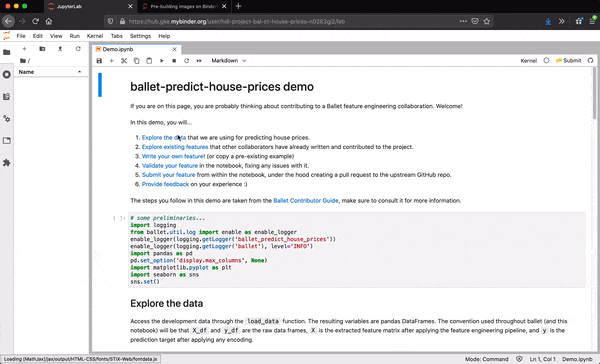ballet-assemble v0.8.8
Assemblé
A development environment for Ballet collaborations on top of Jupyter Lab
Using Assemblé, you can develop patches for Ballet projects within Jupyter Lab and then easily submit them as GitHub Pull Requests (PRs) in one click without leaving your notebook.
Assemblé (pronounced "assam blay") is a ballet move that involves lifting off the floor on one leg and landing on two.
Assemblé is composed of (1) a Python package named ballet_assemble for the
server extension (2) a NPM package also named ballet-assemble for the
frontend extension and (3) tight integration with Binder for each Ballet
project.
Requirements
- JupyterLab >= 2.0
Install
Installation can be done completely using pip, which installs both the
server and the frontend extensions. The frontend extension only can be
installed using jupyter labextension install but will not function properly
without the corresponding server extension.
pip install ballet_assemble
jupyter lab buildNote: You will need NodeJS to install the extension; the installation process will complain if it is not found.
Authenticate with GitHub
The extension provides an in-Lab experience for authenticating with GitHub. When you open a notebook, you should see the GitHub icon to the right on the Notebook toolbar. The icon should be grey at first, indicating you are not authenticated. Click the icon to open a login window, in which you can enter your GitHub username and password. These will be exchanged by the extension for an OAuth token and will be used to propose changes to the upstream Ballet project on your behalf (if you attempt to submit features).

Alternately, you can provide a personal access token directly using the configuration approaches below.
Configure
The extension ties into the same configuration system as Jupyter Lab itself. You can configure the extension with command line arguments or via the config file, just like you configure Jupyter Notebook or Jupyter Lab.
All configuration options
The following configuration options are available:
$ python -c 'from ballet_assemble.app import print_help;print_help()'
AssembleApp options
-----------------
--AssembleApp.access_token_timeout=<Int>
Default: 60
timeout to receive access token from server via polling
--AssembleApp.ballet_yml_path=<Unicode>
Default: ''
path to ballet.yml file of Ballet project (if Lab is not run from project
directory)
--AssembleApp.debug=<Bool>
Default: False
enable debug mode (no changes made on GitHub), will read from
$ASSEMBLE_DEBUG if present
--AssembleApp.github_token=<Unicode>
Default: ''
github access token, will read from $GITHUB_TOKEN if present
--AssembleApp.oauth_gateway_url=<Unicode>
Default: 'https://github-oauth-gateway.herokuapp.com/'
url to github-oauth-gateway serverCommand line arguments
Invoke Jupyter Lab with command line arguments providing config to the ballet extension, for example:
jupyter lab --AssembleApp.debug=TrueConfig file
Determine the path to your jupyter config file (you may have to create it if it does not exist):
```bash touch "$(jupyter --config-dir)/jupyter_notebook_config.py" ```Append desired config to the end of the file, for example:
c.AssembleApp.debug = True
Troubleshoot
If you are see the frontend extension but it is not working, check that the server extension is enabled:
jupyter serverextension listIf the server extension is installed and enabled but your not seeing the frontend, check the frontend is installed:
jupyter labextension listIf it is installed, try:
jupyter lab clean
jupyter lab buildContributing
Development Install
The jlpm command is JupyterLab's pinned version of
yarn that is installed with JupyterLab. You may use
yarn or npm in lieu of jlpm below.
# Clone the repo to your local environment
# Move to ballet-assemble directory
# Install server extension
pip install -e .
# Register server extension
jupyter serverextension enable --py ballet_assemble
# Install dependencies
jlpm
# Build Typescript source
jlpm build
# Link your development version of the extension with JupyterLab
jupyter labextension link .
# Rebuild Typescript source after making changes
jlpm build
# Rebuild JupyterLab after making any changes
jupyter lab buildYou can watch the source directory and run JupyterLab in watch mode to watch for changes in the extension's source and automatically rebuild the extension and application.
# Watch the source directory in another terminal tab
jlpm watch
# Run jupyterlab in watch mode in one terminal tab
jupyter lab --watchUninstall
pip uninstall ballet_assemble
jupyter labextension uninstall ballet-assembleRelease process
bumpversion <part>
make releaseCredits
Contributors
- Micah Smith (micahs@mit.edu)

